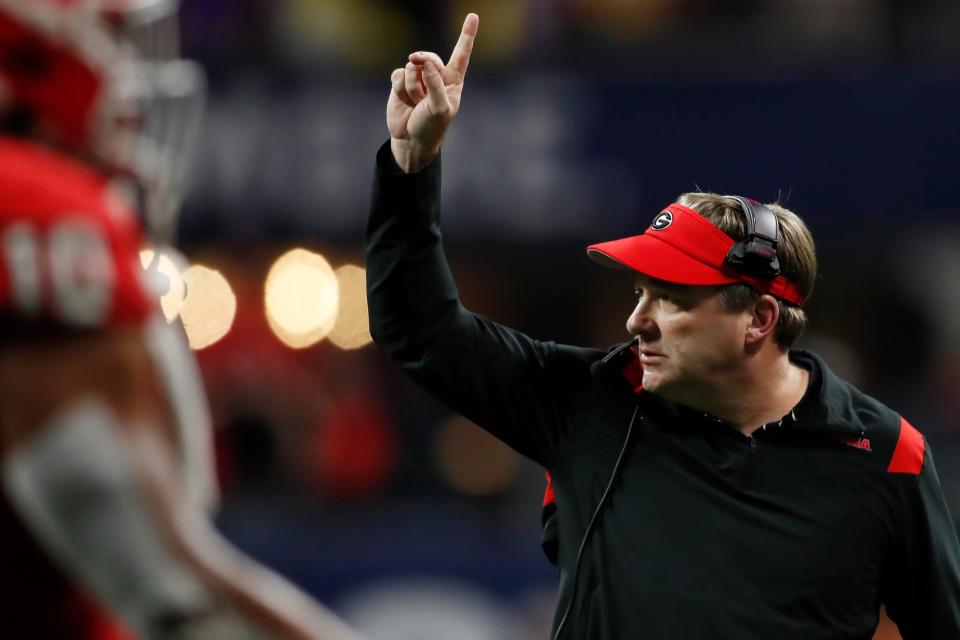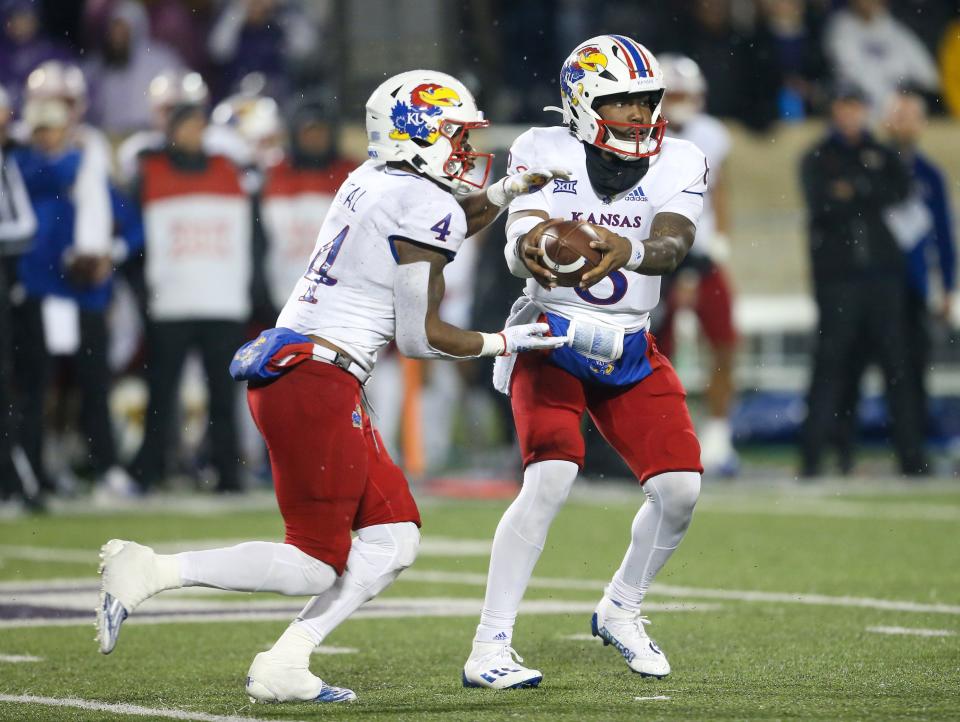College football bowl season arrives in earnest, bringing a little something for everyone
The 2022 college football was full of surprises and disappointments and highs and lows among the 131 teams competing in the Bowl Subdivision. Four made the College Football Playoff. Another eight reached the New Year's Six games, and 82 have scheduled dates in the postseason.
The extravaganza starts Friday and for three weeks, there will be wall-to-wall games culminating in the playoff semifinals and the national championship game. There's new blood in the final four and some familiar faces. The same is true in the other major bowls and throughout the rest of the bowl lineup. There's something for everyone.
These are the best storylines from this year’s postseason to keep you busy into the New Year:
BOWL SCHEDULE: The complete list of all 42 matchups
TRANSFER PORTAL: Power Five teams looking for QBs in the transfer portal
NEWSLETTER: Sign up to get the latest news and stories delivered to your inbox
Redemption for TCU
In the first season of the playoff, the Horned Frogs entered the final weekend ranked No. 3. They then dropped three spots and missed the semifinals despite overwhelmingly beating Iowa State. It would have been understandable if TCU fans were having flashbacks to 2014 and feeling uneasy with the Frogs also at No. 3 before this year’s Big 12 title game and then losing in overtime to Kansas State.
Instead, the committee kept the Horned Frogs at No. 3, and they will face Michigan in the Fiesta Bowl. The selection made some history. TCU became the first Big 12 team besides Oklahoma to make the playoff, and Sonny Dykes became the first head coach to lead his team into the field during his first season with the program. Oklahoma's Lincoln Riley and Ohio State's Ryan Day did it in their initial campaigns, but both were assistants at those schools. TCU is also the first team from the state of Texas to be selected.
The others have been here before
The rest of the College Football Playoff field has a recognizable look, albeit without the two schools with the most appearances. Alabama and Clemson have participated seven and six times, respectively, but will be heading to New Year’s Six games instead of the semifinals. Oklahoma has made four trips and was not in contention this year. That leaves Ohio State as the most veteran member of this year’s playoff group after being selected for the fifth time. The Buckeyes almost didn’t make it, though. Only a loss by Southern California to Utah in the Pac-12 title game opened a spot at No. 4 and a matchup against No. 1 Georgia in the Peach Bowl.
Had Ohio State missed the field, it would have been the first time at least one of the Buckeyes, Alabama, Clemson and Oklahoma had not been selected. At least three of those schools had been in every playoff since 2015 before only Alabama reached last season’s field.
This will be the third time for Georgia, which was runner-up in 2017 and beat Alabama in the championship game last season. Michigan made its inaugural trip in 2021, losing to the Bulldogs in the Orange Bowl. It’s back for a second season in a row.
While Georgia aims to become the first team to repeat as national champions since Alabama in 2011-12, other schools are hoping to end significant droughts. Michigan last won a share of the title in 1997, Ohio State captured the playoff in 2014 and TCU finished at No. 1 in 1938.

Coaching carousel creates uncertainty
Schools no longer are waiting around when making decisions to fire coaches. The growing importance of the transfer portal and early signing day requires swift action either before or immediately after the end of the regular season. The domino effect of the openings means they are often filled by sitting coaches at other schools, creating further change at a time when teams should be preparing for bowl games instead of wondering who will be their coach next season.
One chain begins with Wisconsin firing Paul Chryst midway through the season. The Badgers then hired Luke Fickell from Cincinnati, which forced the Bearcats to go shopping. They brought in Scott Satterfield of Louisville. That move put the Cardinals on the clock and they turned to former quarterback Jeff Brohm, who had just finished leading Purdue to the Big Ten title game. And the Boilermakers responded by naming Ryan Walters, former Illinois defensive coordinator, their new head coach.
To make things more awkward, Cincinnati and Louisville are playing each other in the Fenway Bowl.
Brohm wasn’t the only coach moving on from his job after leading his team to a conference championship game. North Texas fired Seth Littrell after the team lost to Texas-San Antonio on the final weekend.
The other game of connect the dots started when Auburn let go of Bryan Harsin in November. The Tigers moved to bring in Hugh Freeze from Liberty. The Flames then added Jamey Chadwell of Coastal Carolina. The chain ended with the Chanticleers hiring North Carolina State assistant Tim Beck.
Stars won't be shining in many places
The transfer portal and injury concerns about the NFL draft will greatly diminish some teams. The list of quarterbacks either switching schools or skipping games include Kentucky’s Will Levis, Clemson’s DJ Uiagalelei, Florida’s Anthony Richardson, Notre Dame’s Drew Pyne and Pittsburgh’s Kedon Slovis.
The Guaranteed Rate Bowl will feature two backup quarterbacks as Oklahoma State’s Spencer Sanders and Wisconsin’s Graham Mertz have entered the portal.
Some other potential high draft picks have announced plans to head to the NFL early, including Notre Dame tight end Michael Mayer, Penn State defensive back Joey Porter Jr., Oklahoma offensive lineman Anton Harrison and Oregon defensive back Christian Gonzalez.
Oregon linebacker Justin Flowe is among the big names who won’t play for the school they spent the regular season with after entering the portal. Oregon wide receiver Dont’e Thornton, South Carolina tight end Jaheim Bell, Alabama offensive lineman Javion Cohen and Missouri receiver Dominic Lovett are also on the list.

Other matchups of note
There’s an outsized amount of attention given to the biggest games on the calendar. But there are several worth watching, including three games matching ranked opponents.
The headliner is No. 12 Washington and No. 21 Texas in the Alamo Bowl. The added storyline to this matchup is that Longhorns defensive coordinator Pete Kwiatkowski previously spent seven years in the same role with the Huskies.
No. 19 South Carolina and No. 20 Notre Dame clash in the Gator Bowl. The schools haven’t played since 1984, but they do share one common thread. Hall of Fame coach Lou Holtz’s last two jobs were with the Fighting Irish and Gamecocks.
No. 22 Texas-San Antonio and No. 24 Troy, the respective champions of Conference USA and Sun Belt, will face off in the Cure Bowl.
North Carolina State and Maryland haven’t played since the Terrapins departed for the Big Ten after the 2013 season. They’ll square off in the Duke’s Mayo Bowl.
East Carolina and Coastal Carolina are in neighboring states but have never played before their matchup in the Birmingham Bowl. In fact, the Chanticleers haven’t faced a team from North Carolina since their move to the FBS, except for the Sun Belt’s Appalachian State.
BYU and SMU, who meet in the New Mexico Bowl, played in one of the memorable postseason games. The Mustangs led the 1980 Holiday Bowl by 20 points in the final three minutes before the Cougars rallied for a win on a Hail Mary on the final play.
Several bowl mainstays will be staying home
With all but 49 programs in FBS involved in the postseason, you might think most of the biggest names in the sport are included. However, several bowl mainstays will be staying home.
Perhaps the biggest is Texas A&M, which started the season ranked No. 7 in the preseason coaches poll and finished 5-7. The Aggies played in every postseason from 2009-20 and were set to participate in the Gator Bowl last year before having to opt out because of COVID-19 positive tests. The 12-game bowl run was the longest active streak that ended this year.
A&M wasn’t the only team that started the season in the top 25 and finished with fewer than six wins. Michigan State and Miami (Florida) were No. 14 and No. 17, respectively. Both flamed out with some inexplicable losses.
Auburn wasn’t ranked, but not playing in a bowl still was a surprise. The Tigers had made nine consecutive trips and only missed two seasons this century before going 5-7.
Virginia Tech faltered in Brent Pry’s first season, meaning it misses out for the second time in three seasons after playing in the postseason every year from 1993-2019.
Iowa State had been to five bowls in a row, the longest run in school history. West Virginia is staying home after 18 bowls in 20 seasons.
And then there’s Nebraska. The Cornhuskers failed to reach the postseason for the fifth time in the five seasons under now-fired Scott Frost and remain stuck on 53 appearances.

But some schools are making returns
It’s not all bad news. There are celebrations at programs that have returned to the postseason.
Kansas has the longest drought among schools in the Power Five, but the Jayhawks got to six wins in Lance Leipold’s second season and will head to the Liberty Bowl, their first trip since the 2007 season.
Duke won eight games in Mike Elko’s first year and ended an absence dating to 2018. That’s the last time Syracuse also was in a bowl, but the Orange made it and possibly got Dino Babers off the hot seat.
There was first-season success for Jim Mora, too, as Connecticut made the postseason for the first time in seven seasons. Bowling Green also had an absence dating to 2015 that is now over.
Bowls by the numbers
Among the 41 states where Football Bowl Subdivision programs reside, all but five will be represented in the postseason. Arizona, Massachusetts, Nevada, Nebraska and New Jersey are the ones left out.
The Southeastern Conference leads all leagues with 11 bowl berths as Vanderbilt joined Auburn and Texas A&M as the only schools that did not qualify. The Atlantic Coast Conference and Big Ten had nine teams apiece. The Big 12 had eight of its 10 teams get berths, while the Pac-12 rounded out the Power Five with seven selections.
Among the Group of Five, the American Athletic, Mountain West and Sun Belt had the most with seven teams.
This article originally appeared on USA TODAY: College football bowl season arrives. These are the biggest storylines

 Yahoo Sports
Yahoo Sports 
